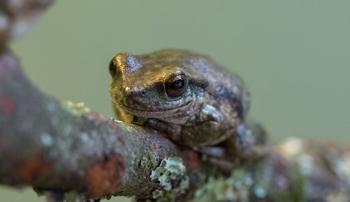Spotted Tree Frog
Populations of the Spotted Tree Frog have declined to the point that it is now Critically Endangered.
This species can live up to 10 years, which is quite old for a frog. It lives in the mountain streams of north-eastern Victoria and southern New South Wales. Now it’s only found in a few rocky mountain streams. The Spotted Tree Frog is a small, often vivid green frog with bumps all over its skin.

Major threats
Like most Australian and international frogs, the Spotted Tree Frog is threatened by the disease, Chytridiomycosis. This is caused by the rapidly spreading Amphibian Chytrid Fungus. Populations of the Spotted Tree Frog are also affected by trout and disturbance to the habitat.
The plan for fighting extinction
Zoos Victoria is playing a major role in the Spotted Tree Frog Recovery Program. We maintain a population in captivity and help monitor the existing populations. This includes re-introducing frogs into the wild.
In February 2024, 70 juvenile Spotted Tree Frogs were returned to the slopes of Mt Beauty as part of the species' conservation breeding and release program. A further 300 tadpoles and other frog species will be released in the coming weeks. More than 800 individuals have now been bred at the Amphibian Bushfire Recovery Centre at Melbourne Zoo and the Threatened Amphibian Biolab at Healesville Sanctuary, with a second generation in waiting to either contribute their genetics to the program or to become candidates for future wild releases.
How you can help
- Donate if you can, because every little bit helps. You can help us continue to make a major contribution to the Spotted Tree Frog Recovery Program. As we are a not-for-profit organisation, all donations go toward our important conservation efforts.
- By visiting Healesville Sanctuary, Melbourne Zoo or Werribee Open Range Zoo, you are supporting our work to fight extinction.
- Discover more about local conservation events and join the growing number of wild activists taking action for local wildlife.
The Amphibian Bushfire Recovery Centre was funded by the Australian Government’s Bushfire Recovery Program for Wildlife and their Habitats and donations to Zoos Victoria’s Bushfire Emergency Wildlife Fund. The Threatened Amphibian Biolab was funded by the Victorian Labor Government, Cadbury’s Save The Frogs initiative, the Estate of Audrey Lillian Barzowski, and philanthropic contributions to Zoos Victoria and its Bushfire Emergency Wildlife Fund.
The Spotted Tree Frog Project is supported by the Australian Government’s National Environmental Science Program through the Threatened Species Recovery Hub and funding from the Australian Government’s Bushfire Recovery Program for Wildlife and their Habitats, which is supported by the Victorian Labor Government’s Bushfire Biodiversity Response and Recovery program. Zoos Victoria is grateful for funding support towards this project from The Calvert-Jones Foundation, the Standish Family Fund, part of the Australian Communities Foundation, Annie and John Paterson Foundation, and Sticky Frogs Australia – in Memory of Gumby.
Is your classroom learning about the Spotted Tree Frog?
Browse through our collection of animal teaching and learning resources for students. These include animal toolkits, e-books, Ask a Zoo Expert resources, video showcases and real-world examples to support the VCE Study Design.
